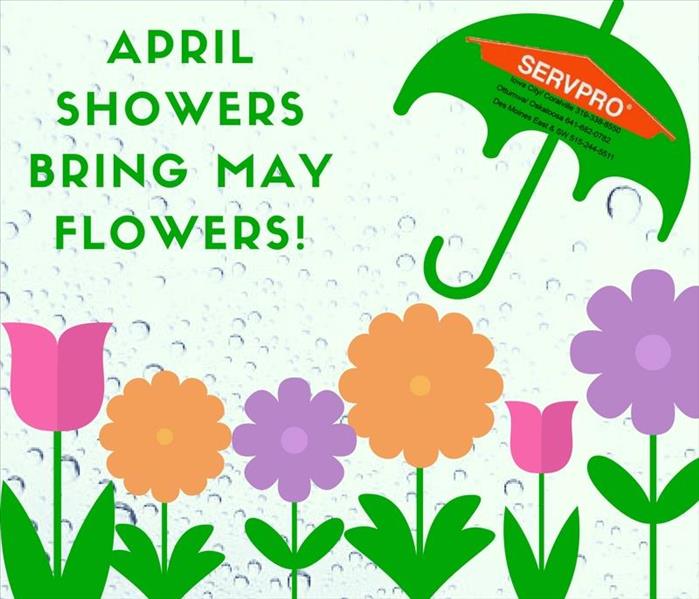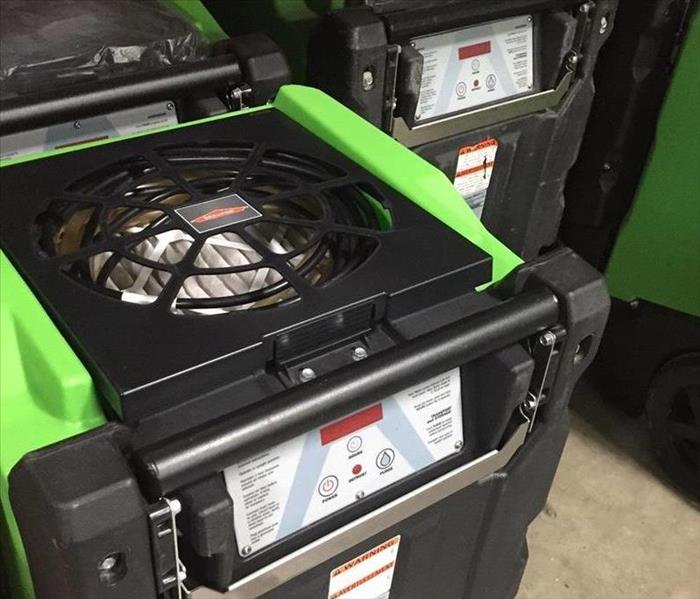Archived Water Damage Blog Posts
Steps to Minimize the Toilet Leak Damage
8/11/2022 (Permalink)
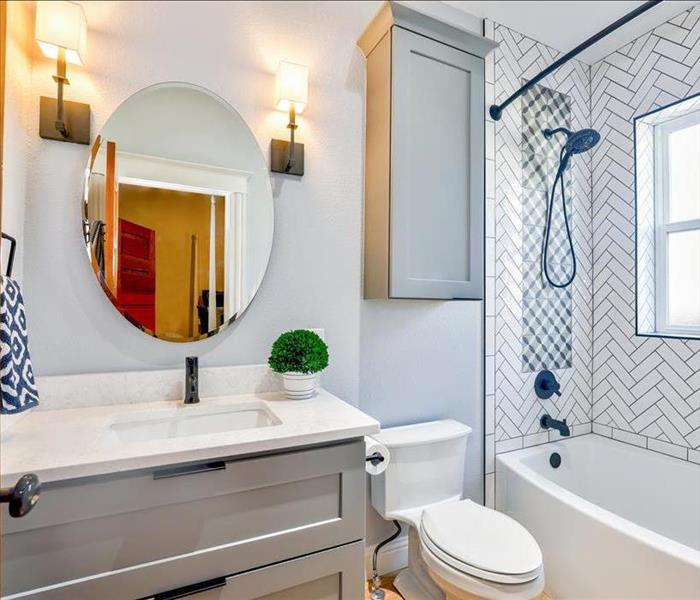 This is when you should call SERVPRO of Des Moines East & SW at 515-244-5511, and our team of professionals will make it ‘Like it Never Even Happened'
This is when you should call SERVPRO of Des Moines East & SW at 515-244-5511, and our team of professionals will make it ‘Like it Never Even Happened'
Hello Des Moines, It’s Digital Marketing Support Coordinator here! After talking to our Office Assistant, Hannah, we found out we see a trend in water loss.
A common water damage we are seeing is toilet water supply lines leaking. If this is in an apartment structure, this runs the risk of the affected unit causing water damage to the unit below it. This type of leak happens when “the joints in the supply line grow weak or become loose” (Rooter Plumbing). If you find your bathroom has a minor or major leak, follow these steps to prevent more damage:
- TURN OFF THE WATER SUPPLY! The valve can be found on the metal tube from the toilet to the wall. Turn the valve clockwise to turn off the water supply.
- You will want to remove the access water in the tank, which happens when you flush the toilet. You can remove the access water by using a material such as a towel to absorb it.
Water Damage to Wood Flooring
7/25/2022 (Permalink)
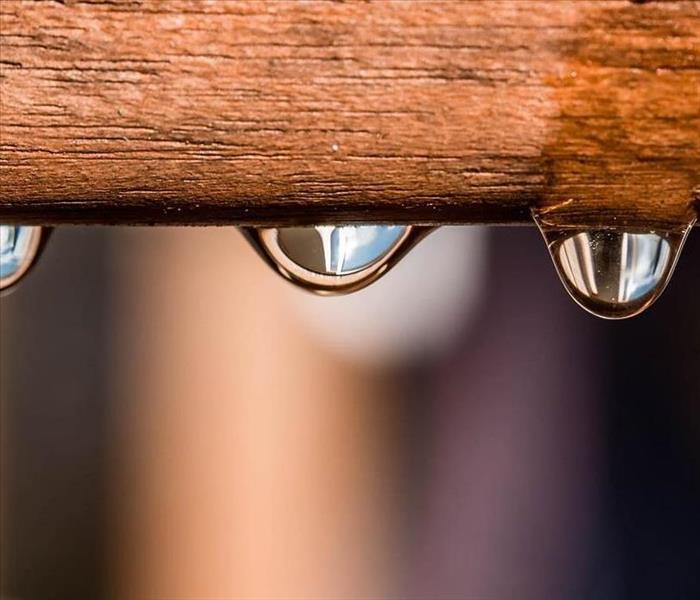 If you notice this type of damage to your property, please call our SERVPRO team.
If you notice this type of damage to your property, please call our SERVPRO team.
Ourteam of professionalsat SERVPROis always making sure to inspect spaces carefully for water damage. While some signs of water damage can go unseen, one indicator of damage is cupping or warping on a wood floor.
Cuppingis when the floor boards create a concave shape with higher sides than the center. Cupping can occur when the underside of the boards gain moisture.Warpingis more severe than cupping because it involves the floor buckling or popping off of the subfloor. Water vapors can cause this to happen.
A problem that can stem from neglecting floors with moisture is the possibility of microbial growth. If this continues without restoration, it can permanently damage your floor.
If you see cupping or warping going on in your property, do not hesitate to contact SERVPRO of Des Moines SW to extract the moisture and remediate the damage.
Microbial Growth Requires Fast Action
7/20/2022 (Permalink)
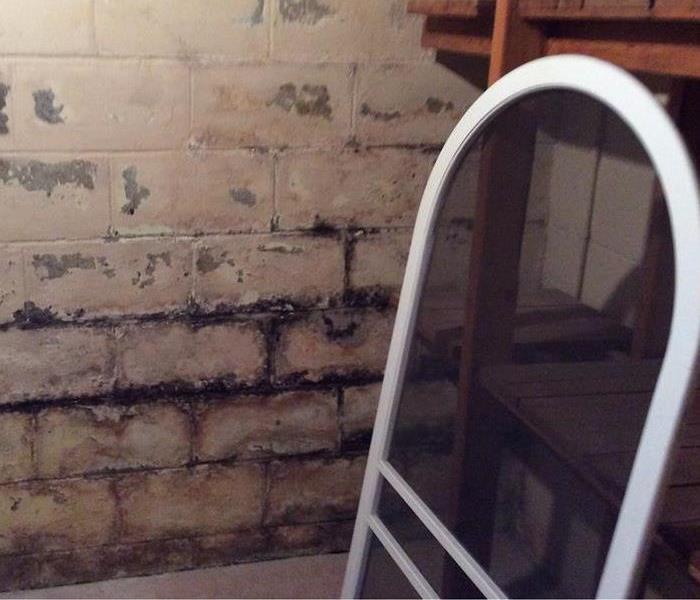 If you discover a water leak, we suggest you call our team at SERVPRO of Des Moines East and SW at 515-244-5511.
If you discover a water leak, we suggest you call our team at SERVPRO of Des Moines East and SW at 515-244-5511.
Hello Des Moines!
It’s Digital Marketing Coordinator Jacob, and I wanted to talk about microbial growth and why it is essential to act fast. Microbial Growth, Mold, is an umbrella term that includes all types of fungi or fungus. In homes that experience a water leak, a pipe bursting, or anywhere that has moisture; there is a chance that it will begin to grow.
Once there is a moisture source, microbial growth will spread and be left untreated. These are not consumable mushrooms, and we suggest avoiding this area due to the severity of growth. If you see mushrooms growing, we recommend leaving it to the experts. When mushrooms grow, it means that the spores are everywhere.
Act Fast With Water Damage!
6/7/2022 (Permalink)
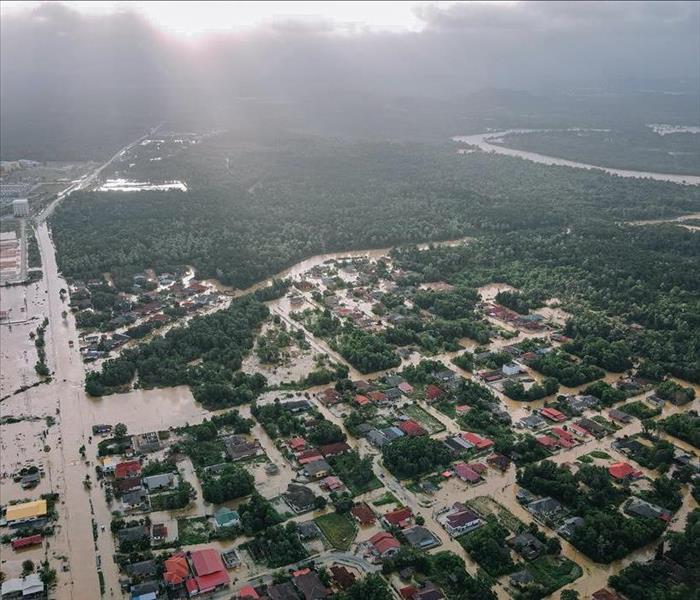 If you have experienced standing water at your property, we recommend that you call our team at SERVPRO of Des Moines East and SW at 515-957-0888.
If you have experienced standing water at your property, we recommend that you call our team at SERVPRO of Des Moines East and SW at 515-957-0888.
One of the reasons we suggest that you have one of our trained Project Managers come to your property is for their endless knowledge. There is a specific timeline we want to be on-site to ensure the initial cause doesn’t create other problems. For example, if your property has standing water, we need to be on-site within 48 hours before the water can start to produce microbial growth.
Four Ingredients for Microbial Growth
- Moisture is the initial cause and probably why you called SERVPRO for help. Flood waters, pipe bursting, and mechanical malfunction are all causes of standing water in homes.
- Microbial growth needs food for it to grow in your homes. Some of the most common materials are wood, cardboard, textiles, and dust-containing skin cells.
- Temperature is what will keep the microbial growth around. Microbial growth thrives in 41-104, while the average household temperature keeps their home at 68-70 during the summer months.
- The last ingredient for microbial growth is oxygen which you probably want to purify.
Tips on how to prevent your pipes from freezing
11/5/2021 (Permalink)
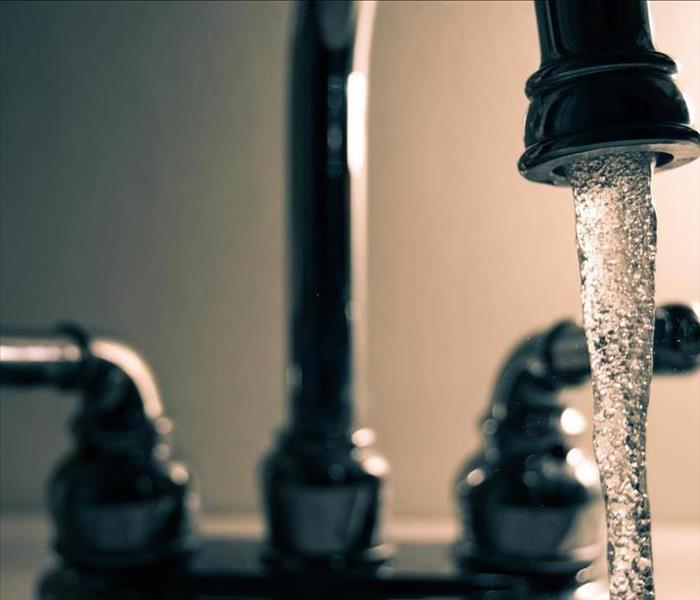 By keeping the faucet slightly running you prevent the chance of pressure building up in the pipe.
By keeping the faucet slightly running you prevent the chance of pressure building up in the pipe.
Last year we all witnessed the extreme cases of pipes freezing in a place you’d never expect, Texas. As we wrap up our warm Iowa months we want to take some time and remind our clients of the steps to take to avoid having their pipes freeze.
Tip 1: Keep the Heat On
One of the easiest ways to avoid having your pipes freeze and burst is to leave the heat on even when you’re not home. When not home it’s okay if you don’t keep the thermostat at the normal temperature that you usually keep it at. In fact, by keeping it set at 50 F or above, you’ll ensure the pipes will stay warm and the chances of them freezing is far less. Some residents will turn their heat off when they’re not home in an attempt to save money on the utility bill. Keep in mind, when a pipe bursts, the cost of the water damage will be far more than a utility bill.
Tip 2: Let the Faucet Drip
When you leave the faucet on just enough to keep it slightly dripping, you’re decreasing your chance of having your pipes burst. This happens when pressure is created between the frozen blockage and the faucet. By keeping the faucet dripping you are allowing the constraint to relieve itself which will prevent any buildup of pressure. Keep the faucet turned towards the hotter side to ensure that it will keep the drain pipes warm. Be conscious of drain traps and keep that constant flow of water so that the drain line doesn’t freeze as well.
What To Do When Dealing With Water Damage
11/5/2021 (Permalink)
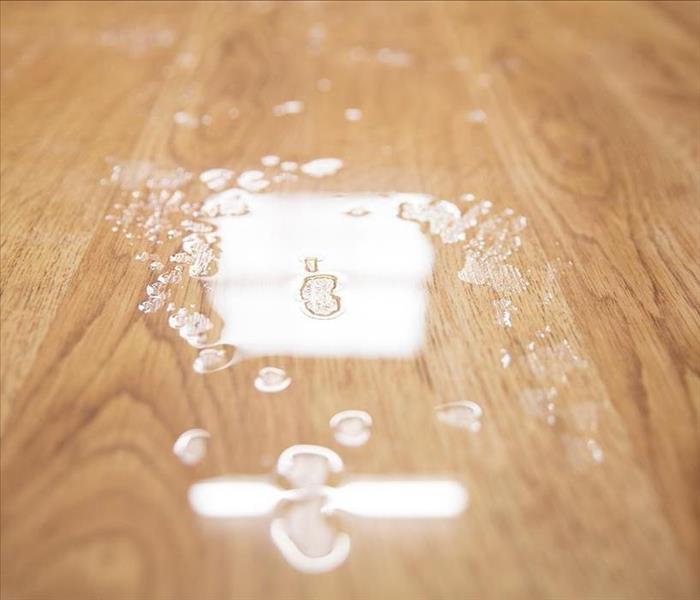 Water pouring out on the hardwood floors causes stress to our clients.
Water pouring out on the hardwood floors causes stress to our clients.
It’s 5 pm, and you get home from a long day at work. You decide to go down to the basement to grab something from the freezer to make for supper. Get to the bottom and smush, water everywhere!
What do you do? Say some choice words and think “Ugh, not today.”
Call your insurance agent to let them know you have a claim to call in, then investigate where the water is coming from.
Water damage does not always come from heavy rain or a storm. It can come from a broken pipe, an overflowing toilet or sink, a crack in the foundation where water may have been pooling. Once you know where the water is coming from, you can begin the steps to stop it and mitigate it.
If the water is indeed coming from a pipe or overflow, it is important to know where your water shutoff is in your home or business. Emergency Ready Profiles are available, it’s a handy tool to know where it is and how to shut it off.
Once that is done, call a restoration and cleaning company, like SERVPRO. Unless you have a water shop vac and a few air movers and dehumidifiers, it may take you a while to clean it and we want to help you avoid microbial growth at all costs. The restoration company can do moisture readings and determine what is needed to dry the space, and get you back to where you were before. They can also determine if any drywall or insulation will need to be replaced or removed, all while working with your insurance and other vested parties. Any reconstruction that may be needed will need to be done by a company that specializes in that but luckily, SERVPRO offers reconstruction services as well as specialized subcontractors to help take care of the project from beginning to end.
It never hurts to do maintenance on any pipes or check on the water shut off, but in the case that something happens and you have water, those are some steps to take towards mitigation!
Our Transparent Way of Categorizing Water Damage
10/28/2021 (Permalink)
Coming from personal experience flooding and the aftermath is a stressful obstacle to overcome. No need to stress because our professionally trained team will have it restored to the preloss condition in a jiffy! In this blog, we will give you a transparent outlook on how our project managers will categorize the type of flood you might be dealing with.
Category 1: Clean source, no risk of sickness
When a project manager labels water damage as a category 1 it means that they found the source of the flood is a clean source and it won’t create any unsafe environment. A category 1 water damage means that the water wasn’t standing for an excessive amount of time which didn’t cause major damage to the structure. Once the project has been classified as a category 1 the team can proceed with structural drying. It is possible to restore the structure to the preloss condition but the team will have to work rapidly to properly dry material, and by replacing materials with permanent structural damager. If the structure has an odor there is a strong chance that it is a category 2.
Category 2: Large Contamination
No need to stress out, once again, our trained professionals are prepared to handle any category. A category 2 is when the water has a significant degree of chemical, biological or physical contamination. Some examples of category 2 would be aquarium leaks, waterbed leaks, toilet bowl overflows, dishwasher or washer discharges. This category has the potential to cause discomfort and shouldn’t be allowed to dwell in a structure for an extended period of time. When our production technicians approach a project of this category they will take special steps and procedures in order to return the structure to the preloss condition. These special steps include; cleaning procedures which must begin before the drying process can begin. Also, any affected carpet underlay must be taken out and disposed of. The carpet MUST be thoroughly cleaned using our hot water extraction method. Finally, our skilled team will employ antimicrobials to mitigate the growth of microorganisms, especially when there are porous materials that are to be cleaned and restored. By thoroughly cleaning and rapid drying the materials we ensure that there won’t be further damage.
Category 3: Dangerous Situation
Although this is a more serious situation you shouldn’t feel stressed because your SERVPRO professionals know exactly how to handle these types of situations, for example, Toilet traps, floodwaters, etc. Our number one priority in this situation is the safety of our production technicians. To ensure that they are completely safe in these situations we have them dress in full PPE: rubber gloves, respiratory protection, rubber boots, body covering, and appropriate eye protection. These technicians want to ensure that communication is constantly flowing so to ensure this they will mark and post areas that are potentially hazardous. To ensure the safety of those living/working in these situations we will evacuate individuals with compromised immune systems until it has been labeled as safe.
Planning Ahead for Drying - Preventing Damage
8/17/2021 (Permalink)
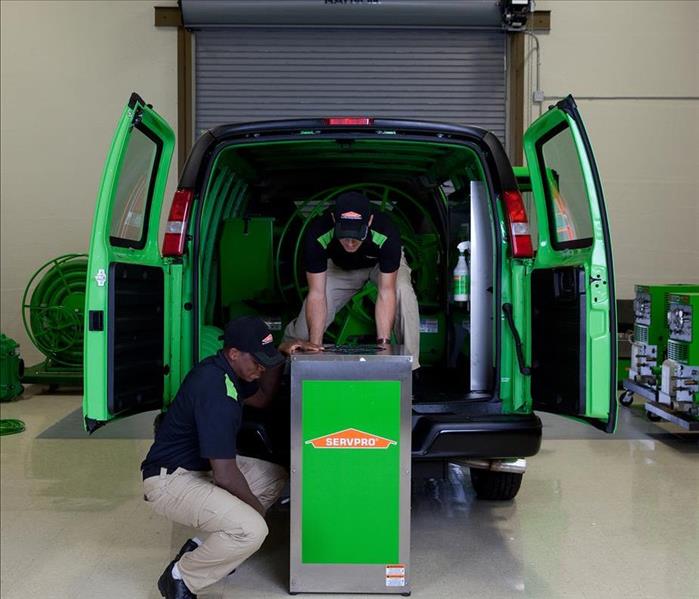 We respond immediately to your emergency and have the expertise to handle your restoration or cleaning needs no matter the size of the job.
We respond immediately to your emergency and have the expertise to handle your restoration or cleaning needs no matter the size of the job.
Water damage can happen almost everywhere in your home or business. Our job as trained professionals is to come in and help you get your property back to preloss conditions. During the extraction process, it is sometimes efficient to plan for drying challenges.
If the structure is cold, then the area needs to be warmed. If a structure has high humidity, then the structure needs drier outside air or needs dehumidifiers to be brought in. This will help get the areas back to a state of dryness. Lastly, if there are strong odors at the job site that are cross-contaminating the unaffected area, then a containment needs to be set up to divide the areas and help the mitigation process move faster in the affected area.
All these pieces are essential in making mitigation and restoration move smoothly for our team members.
Water Categories
7/21/2021 (Permalink)
When it comes to water damage, our team comes prepared for the 3 different categories of water. Three? Yes, three different categories of water, These different levels represent the severity and toxicity of the situation. This spans from a normal mitigation job to biohazard.
There are three different categories that a water loss is classified in depending on the type of water.
- Category 1 Water - Examples are broken water supply lines, tub or sink overflows, or appliance malfunctions that involve water supply lines. Category 1 is from a source of water that does not pose a substantial threat to humans and is classified as "clean water".
- Category 2 Water - Examples are toilet bowls with urine (no feces), sump pump failures, seepage due to hydrostatic failure, and water discharge from dishwashers or washing machines. This source is known as "grey water".Refers to a source of water that contains a significant degree of chemical, biological or physical contaminants and causes discomfort or sickness when consumed or even exposed to. This type carries microorganisms and nutrients of micro-organisms.
- Category 3 Water - This category includes water sources from sewage, seawater, rising water from rivers or streams, ground surface water, or standing water. Category 2 Water or Grey Water that is not promptly removed from the structure and or has remained stagnant may be re-classified as Category 3 Water. This is known as "black water" and is grossly unsanitary. This water contains unsanitary agents, harmful bacteria, and fungi, causing severe discomfort or sickness. Type 3 categories are contaminated water sources that affect the indoor environment.
Protect Your Home
6/1/2021 (Permalink)
Being an active home owner is essential to keeping a safe and protected place for you and your family. Things can change in a split second, so it is best to be prepared for whatever can happen. You want to check for any damages or leaks so that continued damage doesn’t occur. Make sure to check your sump pumps after heavy rain. In addition to this, make sure that the backup battery is charged and ready if needed. Another important piece is to remember to protect your personal contents placed in your house. In your basement, make sure to keep cardboard boxes elevated. If your basement becomes flooded, all the carboard boxes on the ground would then be damaged and unsalvageable. It is essential to be an active homeowner as to keep your property safe and protected.
Detection Equipment
9/28/2020 (Permalink)
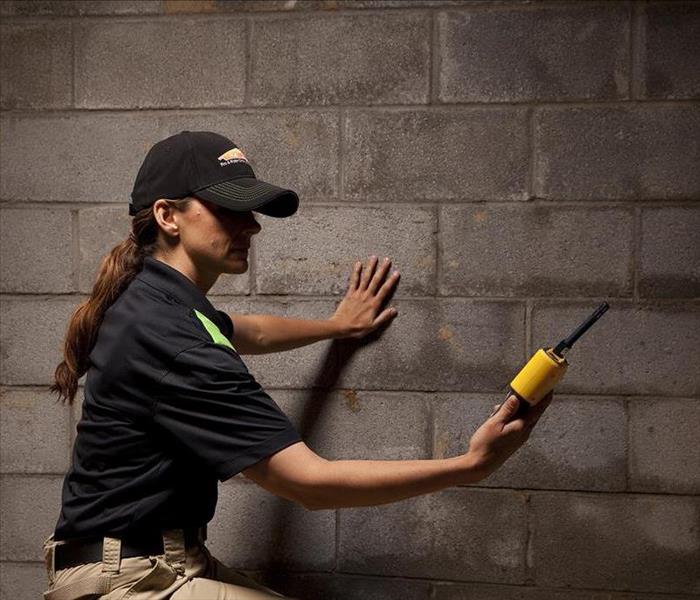 Detection equipment is utilized before, during and after to make sure the structure is thoroughly dried.
Detection equipment is utilized before, during and after to make sure the structure is thoroughly dried.
With every job that is completed, there has to be some sort of preemptive scoping and detection to see what work needs to be completed. Scoping involves locating the areas of the structure affected by water and defining the extent to which the structure and affected contents have absorbed moisture. Detection before and after the job help ensure that the structure has been thoroughly dried. We utilize moisture sensors, moisture meters, and thermohygrometers. Moisture sensors are used to detect moisture in carpets, baseboards and walls. Moisture meters are used to determine the actual moisture of various materials. The moisture tester provides accurate moisture readings that allow team members to accurately monitor the whole drying process. Lastly, the thermohygrometers measure both temperature and relative humidity. These two readings are used with a psychrometric chart to calculate specific humidity, dew point and vapor pressure. All these pieces of equipment are essential to making the job process smooth and efficient.
Extraction Equipment
9/28/2020 (Permalink)
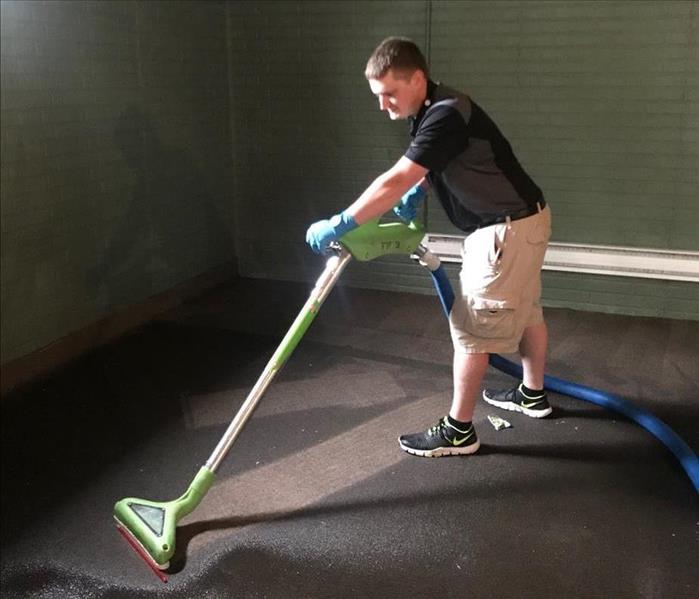 SERVPRO understands the importance of using the proper equipment for your disaster to help mitigate damage.
SERVPRO understands the importance of using the proper equipment for your disaster to help mitigate damage.
When pipes burst and a sudden flood overcomes your home, no matter if it's your basement or bathroom, our SERVPRO franchise professionals are able to help you extract clean or dirty water. The most effective method of removing moisture from a structure is extraction. This is why it is critical to respond quickly to water damage and to provide emergency mitigation services. When the water is extracted quickly, the environment can then usually be dried much faster and mold is less likely to grow. Extractors are used in cleaning carpets and upholstery and in removing water from floors following a water damage. Extractors are essential to remove standing water and saturated floors. This step is essential in the drying process and then moves next to air moving so the rest of the structure can be dried out.
We Are Ready for Your Water Disaster
9/18/2020 (Permalink)
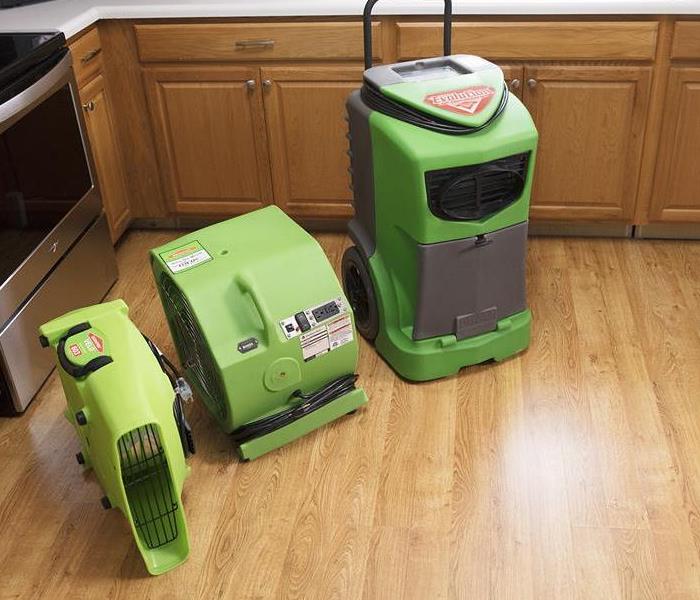 We are capable of handing any size job. We have the equipment for any water damage disaster.
We are capable of handing any size job. We have the equipment for any water damage disaster.
SERVPRO understands that using the proper equipment makes a measurable difference in restoring versus replacing damage items and property. When time matters, technology and equipment must be counted on to perform and help the customer in need. SERVPRO franchise professionals will answer your call with fast action, exceptional equipment, and trained team members who are ready to help. Certainly, the right tools for the job are vital to timely mitigation. Especially in the case of water damage, mold can quickly grow if the source isn't handled. Our professionals thoroughly understand how to dry a structure and personal property effectively. We are trained and have all the needed equipment to assist you in your time of need. When we arrive on-site, we make sure to educate the customer on the services being done.
How We Check for Water Damage
7/21/2020 (Permalink)
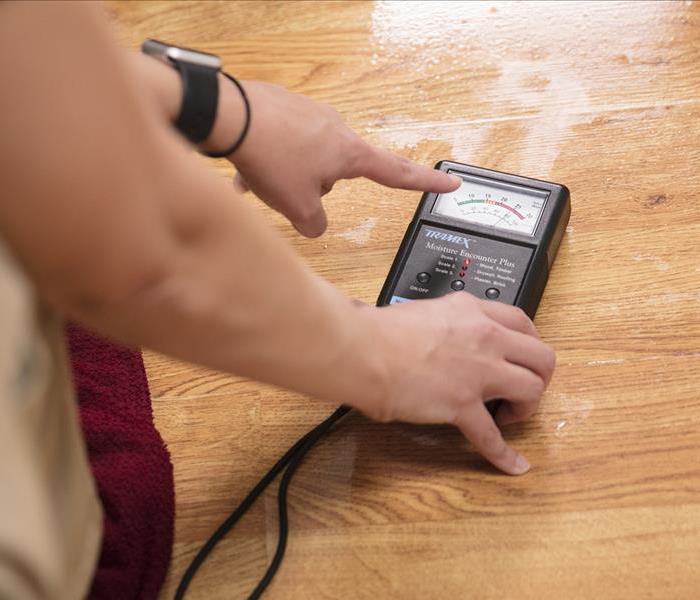 Our equipment is stocked in our vehicles to help with any size disaster.
Our equipment is stocked in our vehicles to help with any size disaster.
It is the water that you don't always see that can cause damage to your property and potentially lead to mold growth. SERVPRO of Des Moines SW and East uses some of the best meters, detectors, and monitoring devices to protect your home or business when water damage occurs. To make sure that the structure is dry and proper moisture progression is taking place, we utilize these tools when drying and monitoring a structure. We do daily monitoring while drying a structure as well as provide moisture checks for residences and commercial locations that have had water infiltration to make sure that the structure is dry and there is not water hiding behind structural materials. A FLIR camera is showing where there is water still trapped in below the flooring material. When you have water damage you can depend on SERVPRO to have the right tools to make sure your structure is properly dry.
The Different Types of Mold You'll Encounter
7/2/2020 (Permalink)
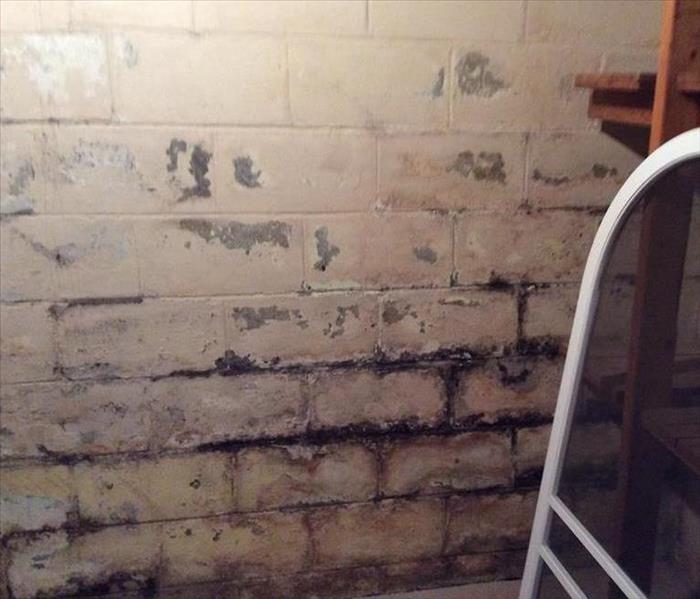 Mold prospers in warm, damp area and it will continue to spread with a continuous water source. Call our professionals to help with mold remediation.
Mold prospers in warm, damp area and it will continue to spread with a continuous water source. Call our professionals to help with mold remediation.
There are different types of mold. The most common are aspergillus, cladosporium and stachybotrys atra (also known as black mold). Aspergillus and Cladosporium are nontoxic to humans but it can aggravate allergy symptoms. It is important to note that not all mold is dangerous. In fact, it is all around us, but some mold should be removed by professionals. It is found in foods and in air conditioning systems. This is found as a black or green mold that grows in little dots in bathrooms, on painted surfaces, and in flexible air ducts. Black mold should be removed for safety reasons. Call our SERVPRO franchise professionals to remove molds such as black mold. This type of mold grows on building materials with a water source available. To prevent mold growth, make sure that water leaks are dried up quickly and humidity levels are maintained in your home or business. Mold thrives in warm, damp conditions. Our SERVPRO franchise professionals are certified to test for mold. We do visual inspections, air sampling, as well as we have a bore scope that can go inside areas that are not normally visible to look for mold. When air samples are taken, 3 samples are taken and sent in to be analyzed. The results take about 5 to 7 days to return. If the air samples come back positive for mold then we will do further investigation to locate the source of the positive result of the air samples. Call us for pricing if you believe you have mold present and we will help you maintain your healthy home remediate mold.
The Do's and Do Not's for Water Damage
7/1/2020 (Permalink)
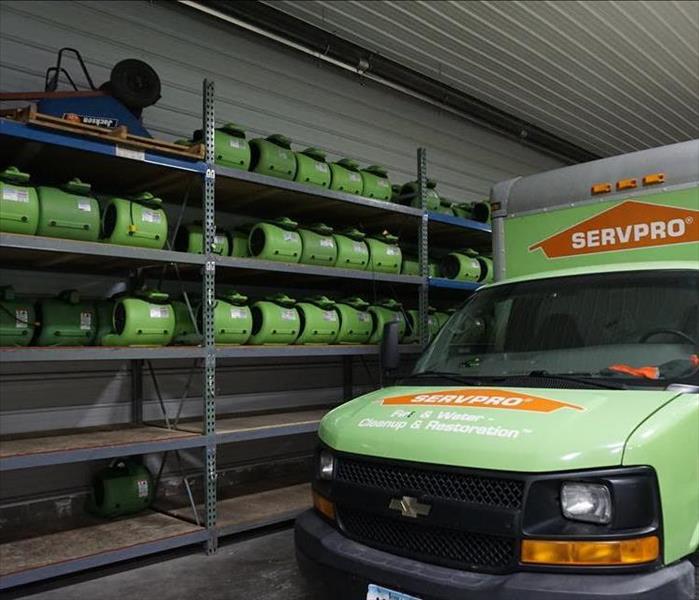 We are fully stocked for any amount of water damage. As franchise professionals, we can help you get toward preloss conditions.
We are fully stocked for any amount of water damage. As franchise professionals, we can help you get toward preloss conditions.
Water damage can happen at any point for anyone, home or business, resulting in sometimes irreversible damaged property. These do's are only for clean water and do not’s pertain to sewage water. Sewage water is treated differently since it causes different damage and requires a different cleanup process. We, the team of SERVPRO of Des Moines SW & East, know the importance of having professionals helping you properly dry out your home after water damage. With the right tools and pieces of equipment our SERVPRO franchise professionals can safely dry out your home or business and the contents within it. If the proper methods are administered then it minimizes the removal of materials such as drywall (this is also dependent on how soon the water damage is being dealt with. To minimize the damage, make sure to shut off the source of water and turn off the electricity. It is essential to remove as much excess water as possible by mopping and soaking up with towels. This is especially important for wood furniture. To ensure that more damage isn't sustained by the furniture, place aluminum foil in between furniture legs and the carpet. While these are good steps, your safety is important, so make sure to NOT enter a room with standing water since there could be a risk of electrical shock. We take safety very seriously and we want to ensure your safety along with our own. Make sure to disconnect all power first. It is recommended to NOT leave rugs and furniture upholstery wet against one another, because the fabrics have the potential to bleed between each other. It is important to note that you should not be utilizing your household vacuum to try and suck up any water. If these tips are followed, then damage can be minimized and you will be better prepared for help to arrive. Remember to stay safe and get excess water cleaned up professionally to minimize the chance of mold growth.
What Is A Desiccant?
5/13/2020 (Permalink)
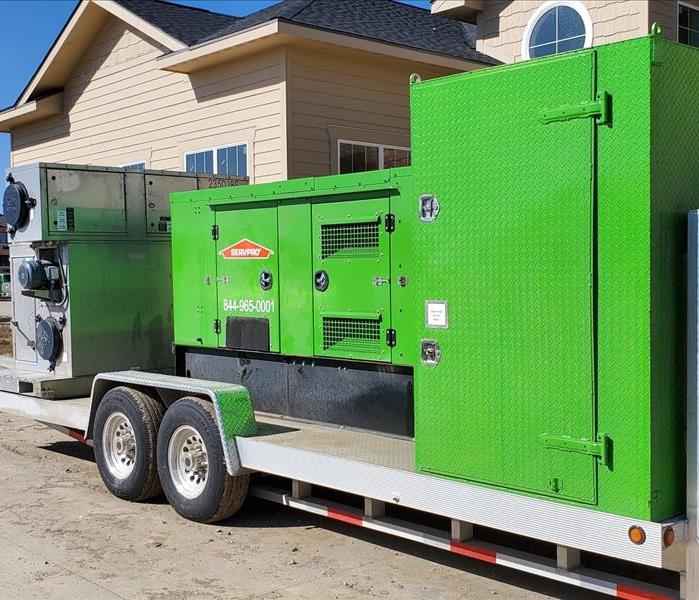 This large scale dehumidifier is meant for large loss scenarios.
This large scale dehumidifier is meant for large loss scenarios.
Our desiccant helps the process of bringing the affected area back to a state of dryness and is mainly used for commercial losses. More specifically, it helps mitigate water damage. For larger scale losses, it acts as a large dehumidifier utilizes a generator to help with the process. These use an absorbent material to extract water from the air. The material is heated to drip the moisture into a water tank. Desiccant dehumidifiers are designed to work more effectively in lower temperatures. Dehumidifiers are designed to keep a room’s humidity levels in check, so the air is more comfortable and fewer physical signs of damp air are noticed, helping minimize the chance of mold. The desiccant can be utilized if your home has been flooded, especially if the wood is soft to touch in that area. Softwood can indicate rotting and windowsills are particularly vulnerable. If you notice mold or mildew then SERVPRO of Des Moines East & SW can use the desiccant to help get the moisture in the air and materials to a more stable level. Desiccants are used on a larger scale water loss to remove moisture from the air. We used these as a tool in our balanced drying system in place or alongside dehumidifiers on a larger scale project. Desiccants operate differently than dehumidifiers. Desiccants do not collect water through condensation. They vent moisture-laden air from inside the structure to outside the structure using a ventilation system. Desiccants are usually large units and sit outside the structure with venting tubes and air input tubes from and to the structure. They create the greatest vapor pressure and are best used when trying to dry wood flooring, plaster, or concrete. They work on the principle of sorption rather than condensation. Water vapor in this process is adsorbed by a silica gel and then that silica gel is reactivated by energy causing the desiccant to release its moisture to the outside air.
How To Handle Water Damage
5/13/2020 (Permalink)
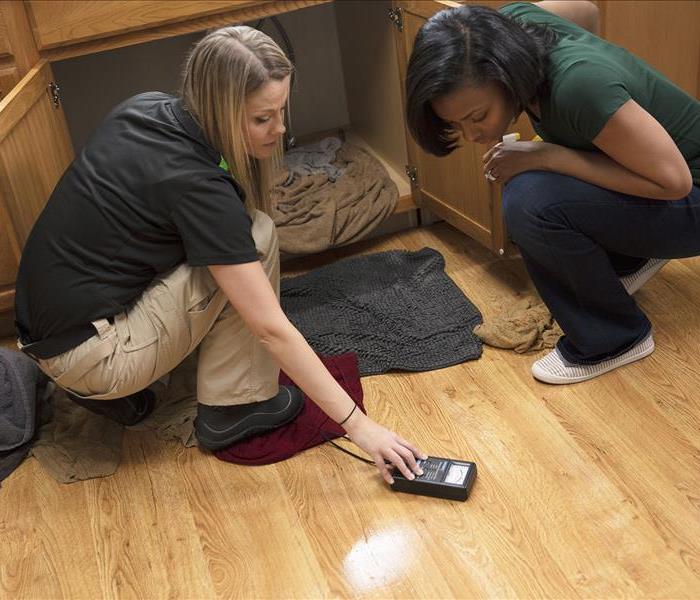 Our team consists of franchise professionals and are capable and prepared for water damage.
Our team consists of franchise professionals and are capable and prepared for water damage.
Water damage can happen at any point for anyone, resulting in sometimes, irreversible damaged property. These do's are only for clean water and does not pertain to sewage water. Sewage water is treated differently since it causes different damage. We, the team of SERVPRO of Iowa City/Coralville, know the importance of having professionals helping you properly dry out your home after water damage. With the right tools and pieces of equipment our team can safely dry out your home or business and the products within it. If the proper methods are administered then it minimizes the removal of materials such as drywall (this is also dependent on how soon the water damage is dealt with. To minimize the damage on your property, make sure to shut off the source of water and turn off the electricity. It is essential to remove as much excess water as possible by mopping and soaking up with towels. This is especially important for wood furniture. To ensure that more damage isn't sustained by the furniture, place aluminum foil in between furniture legs and the carpet. While these are good steps, your safety is important, so make sure to NOT enter a room with standing water since there could be a risk of electrical shock. Make sure to disconnect all power first. You shouldn’t leave rugs and furniture upholstery wet against and sitting on carpets, because the fabrics have the potential to bleed between each other. It is important to note that you should not be utilizing your household vacuum to try and suck up any water. If these tips are followed, then damage can be minimized and you will be better prepared for help to arrive. Remember to stay safe!
When it Rains, It Pours - Water Clean Up Service
9/27/2019 (Permalink)
Rain can cause unseen damage getting into small cracks in your foundation or flooring, around windows, or even from non functioning sump pump systems which can lead to all sorts of damages if not addressed timely. Here at SERVPRO of Des Moines East and SW we understand how frustrating it can be to discover rain related water intrusions which are a leading cause of water damage to a home. The sooner mitigation and extraction of the standing water begins the better to prevent further damage. Identifying the source and preparing it is extremely crucial. We are a 24 hour, 7 day a week company and will work hard to get the issues resolved in a timely manner. With our professionally trained and certified team we are here to help and get your life back to normal as quickly as possible. Inspecting common leak sources routinely and looking at your exterior foundation can help prevent rain and surface runoff intrusions.
Protecting Your Personal Belongings From Water Damage
9/26/2019 (Permalink)
In the event you have experienced any kind of water damage in your home or business, there are steps that you can take to protect your personal belongings.
While you wait for SERVPRO to arrive you should:
- Move any furniture with wooden feet or legs that you can safely carry out of the affected area. You can use a non-porous object such as coasters, plastic wrap, Styrofoam, aluminum foil, etc, to block the furniture and lift the legs out of the water. At SERVPRO of Des Moines East & SW, we use styrofoam blocks to lift furniture out of wet areas. However, it is okay to be creative as a homeowner to find other household items that can serve the same purpose. The important thing is preventing water damage to your furniture.
- Store any belongings in plastic totes. If your belongings are stored in cardboard, move any wet cardboard boxes to a dry area. It’s also a good idea to dry off items that are wet before placing them in storage.
- Move electronics that have been saturated by water to a dry area and wipe down with a clean, dry rag.
- Take pictures! Our staff takes pictures for your insurance company when we arrive, but if you do happen to move anything or have something that is really damaged, make sure to take pictures of those items.
The more contents you can move yourself, the less damage you will have to your furniture and personal items. This will also help our SERVPRO team get to work immediately extracting water and setting drying equipment.
Water Cleanup by The Best
9/20/2019 (Permalink)
If you experience an inconvenient water intrusion in your home or business the highly-trained and trusted specialists at SERVPRO of Des Moines East and SW can assists in getting you back to "Like in never even happened." At SERVPRO we are ready for whatever happens by keeping our technicians trained and armed with the latest in moisture mapping technology. We invest to make sure we can provide our communities with the top of line dehumidification and drying equipment in the industry. We also have experience in document restoration. If ever water enters your home or business and compromises important photos, passports, bank papers, titles. We are ready to help you when you need it. Our drying techniques and practices are backed with years of success. Call us 24/7, 365 whenever you need us and we will be there. We armed with trained technicians toting with them the best equipment and testing tools in the industry.
Water Damages Are Not All Treated The Same
6/12/2019 (Permalink)
SERVPRO of Des Moines SW & East is here to help when water damage happens. Our IICRC trained staff will take many steps in cleaning up the damage. The first step is to determine the cause of the water damage and select the Category of water.
There are three different categories that a water loss is classified in depending on the type of water.
- Category 1 Water - Examples are broken water supply lines, tub or sink overflows, or appliance malfunctions that involve water supply lines. Category 1 is from a source of water that does not pose substantial threat to humans and classified as "clean water".
- Category 2 Water - Examples are toilet bowls with urine (no feces), sump pump failures, seepage due to hydrostatic failure, and water discharge from dishwashers or washing machines. This source is known as "grey water".Refers to a source of water that contains a significant degree of chemical, biological or physical contaminants and causes discomfort or sickness when consumed or even exposed to. This type carries microorganisms and nutrients of micro-organisms.
- Category 3 Water - This category includes water sources from sewage, seawater, rising water from rivers or streams, ground surface water, or standing water. Category 2 Water or Grey Water that is not promptly removed from the structure and or have remained stagnant may be re classified as Category 3 Water. This is known as "black water" and is grossly unsanitary. This water contains unsanitary agents, harmful bacteria and fungi, causing severe discomfort or sickness. Type 3 category are contaminated water sources that affect the indoor environment.
How To Check For Water Damage
2/20/2019 (Permalink)
It is the water that you don't see that can cause damage. SERVPRO of Des Moines SW and East uses some of the best meters, detectors, and monitoring devices on the market to protect your home or business when water damage occurs. To make sure that the structure is dry and proper moisture progression is taking place we use these tools when drying a structure. We do daily monitoring while drying a structure as well as will provide moisture checks for residences and commercial locations that have had water infiltration to make sure that the structure is dry and there is not water hiding behind structural materials. This picture shows a infrared camera, called a, FLIR camera. This camera is showing where there is water still trapped in below the flooring material. When you have water damage you can depend on SERVPRO to have the right tools to make sure your structure is properly dry.
Hard Wood Floor Damage
2/20/2019 (Permalink)
When you have hard wood floor damaged by water you can depend on SERVPRO of Des Moines SW to have the specialty drying systems needed to be able to help possibly restore your flooring. Hard wood floor drying systems include mats, air movers, and dehumidification equipment to be able to remove the water trapped by the flooring. The trick to being able to save the flooring is speed. Quick extraction of standing water and quick setting of the floor system is key. If too much warping of the wood has taken place it is hard to bring the wood back to its original state. When water damage occurs to any hard wood flooring it is best to call SERVPRO and have them do a moisture check of the floor and make sure the flooring is dry and there is not any unwanted moisture trapped under the floor to prevent further damage days later. SERVPRO has the equipment for residential losses or even large commercial wood floors like those that are installed in gymnasiums.
Water Damage Clean Up in Des Moines Requires Air Flow
7/25/2018 (Permalink)

When your business or home are affected by water damage and you don't know what to do you can trust that SERVPRO of Des Moines SW has the equipment necessary to provide the mitigation services you need. When you find water damage call our office right away and we will be out to provide a plan of action and start providing services to stabilize the structure to minimize any further damage from occurring. A big part of properly mitigating a water damage is air flow and providing the right amount of air flow for the affected square footage. With our trained technicians taking measurements and assessing the situation this is figured out. We can then provide the right amount of equipment to properly mitigate the situation. This picture shows a few different types of air movers we have on the same job and how we affectively space them to provide airflow to affected materials. The metal silver fan in the front corner is the clients on this job. You can see the difference on this job of what was actually needed for air flow.
Drying Up After Water Damage In Des Moines
6/28/2018 (Permalink)
When water affects your business or home SERVPRO of Des Moines SW is here to help with equipment and trained staff.
This business had water damage after a heavy rain storm in a short amount of time. The water came into their building and affected the entire location. We extracted the standing water and set equipment. We set a total of 387 fans on this particular job, as well as desiccants and generators as you can imagine it took lots of power to run all this equipment. We have the means to be able to dry the structure. Air flow is a big part of the drying process. Having the right amount of air flow is crucial to the drying process. We use calculations to figure the right amount of equipment needed to properly dry the structure and contents in a facility. We are here to help you with our trained professionals when disaster happens to get you back to your home and business faster, making it "Like it never even happened."
Water Removal After Storms
6/14/2018 (Permalink)
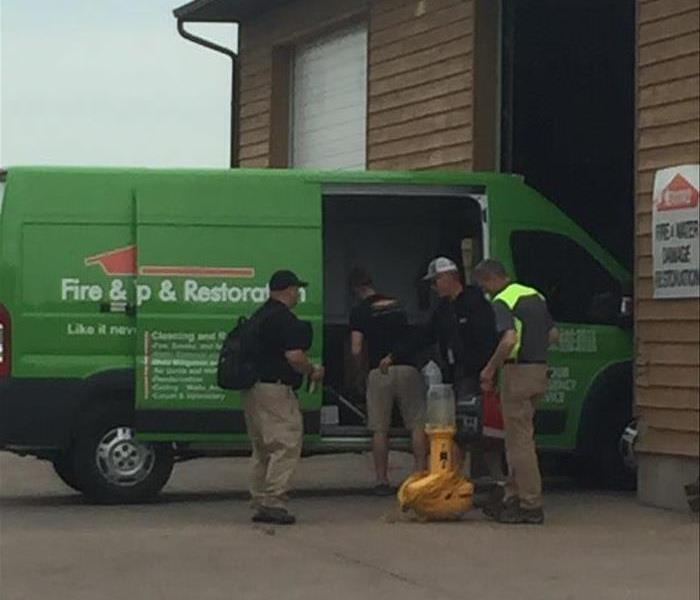 Crews Loading Up The Vans
Crews Loading Up The Vans
Today in the Des Moines area we received a very large amount of rain in a short amount of time. Our crews as soon as the rain started falling in central Iowa were making sure the trucks were loaded and ready. This happens every day though. We make sure we are ready to help when the help is needed. We are able to dispatch the teams quickly to your home or business. We can help you extract the water when your sump pump fails, water infiltrates your foundation, or your sewer backs up. We can dry the structure of the building or even do demo of the affected materials so that the reconstruction can start that much quicker. It is all about getting you back to normalcy as quickly as possibly. Disasters happen but it doesn't have to be that way for long. Let the professionals help.
April Showers bring May flowers and the possibility of flooding to your Des Moines area home.
4/4/2018 (Permalink)
April Showers do bring May flowers but they also bring flooding. Taking precautions can help minimize the damage that occurs at your home. The first thing you need to do is check with your insurance to make sure that you are covered. Coverage options vary depending on the insurance company so it is always a good idea to check and see what is available to you. Second, have your sump pump and chimney checks yearly and make sure your gutters are clean and attached properly. If water does get into your home it needs to be removed quickly and dried out properly so you don’t have mold growth in the future. SERVPRO of Des Moines SW will respond to the problem and extract the water and start the remediation process to prevent mold growth at all affected levels.
"We're all mad here."
2/15/2018 (Permalink)
When you have severe water damage at your home you might go MAD trying to coordinate everything with insurance, mitigation, content cleaning, and then you might have to worry about reconstruction. One thing that you might not think about is all of your important documents and pictures that might have been damaged. You wouldn’t want your marriage license or your Great Grandma’s bible to grow mold because you forgot it had gotten wet in all the hustle of the water damage. We can dry your books, pictures, paintings, and important documents for you.
The Mad Hatter said “No wonder you’re lat. Why, this watch is exactly two days slow.” You don’t have to worry about our clocks being slow because we are a 24/7 company.
Let us help keep the romance lit in Des Moines
2/12/2018 (Permalink)
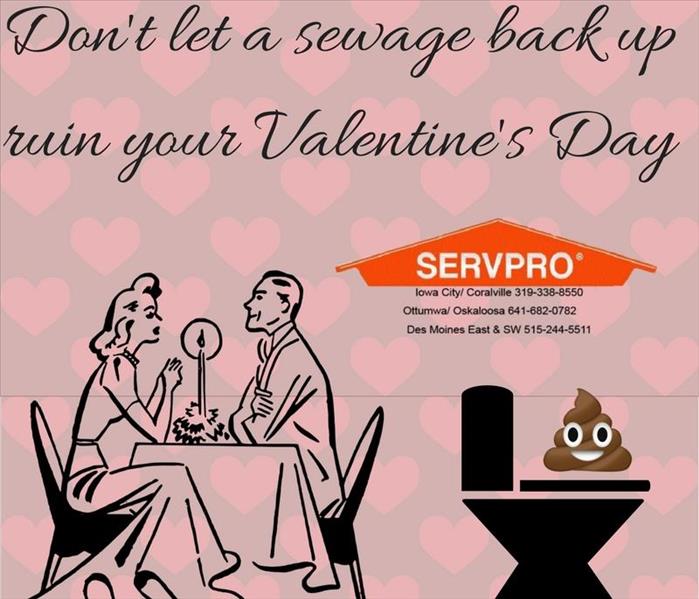 SERVPRO of Des Moines SW is working to ensure that your romantic plans don't get interrupted.
SERVPRO of Des Moines SW is working to ensure that your romantic plans don't get interrupted.
You have been planning this day out for weeks. The flowers have been delivered, the table is set, and the wine is poured. You are sitting down with your significant other for a romantic candlelit dinner at home. Right before you put dessert on the table you get a smell of something very unpleasant. You search your home to find where the stench is coming from and it is a sewage backup in your bathroom. Sewage back up can occur for a variety of reasons. Don’t let it ruin your romantic night in. You won’t want to clean up the mess yourself put your trust in SERVPRO of Des Moines SW and give us a call. We will come in, extract the water, deodorize, clean your damaged contents, and restore carpets and floors.
Call us today to help make sure your romantic night can resume.We work hard to make it "Like it never even happened."
Water Clean Up in Des Moines, Altoona and Surrounding Areas
7/25/2017 (Permalink)
When water damage happens in Des Moines, Altoona, and the surrounding areas don't hesitate with who to call. Call SERVPRO of Iowa City/Coralville, Ottumwa/Oskaloosa, Des Moines East & SW. We are the largest SERVPRO in the state of Iowa but we are here to handle everything from a small water leak to a large flood. We can clean up fresh water from a water line break from a washing machine, dish washer, sink, refrigerator, or even water from an air conditioner condensate line. We can clean up water that has backed up from a drain line or from a sump pump that has quit working.
It is so important to call us right away. It is the water you don't see that can cause the most damage. We do free estimates and free moisture checks. Don't hesitate to call.
We have equipment loaded and ready to go and crew that works 24 hours a day to help you and respond to your loss right away to start extracting water and we will set dehumidifiers and air movers if needed as soon as we can to keep the water from wicking further into the structure.
You can trust us. With our three locations to have staff ready to help you 24 hours a day. So when you have water to clean up we are here to help you. Thank you for trusting us.
Removing water from Carpet in Ankeny
6/26/2017 (Permalink)
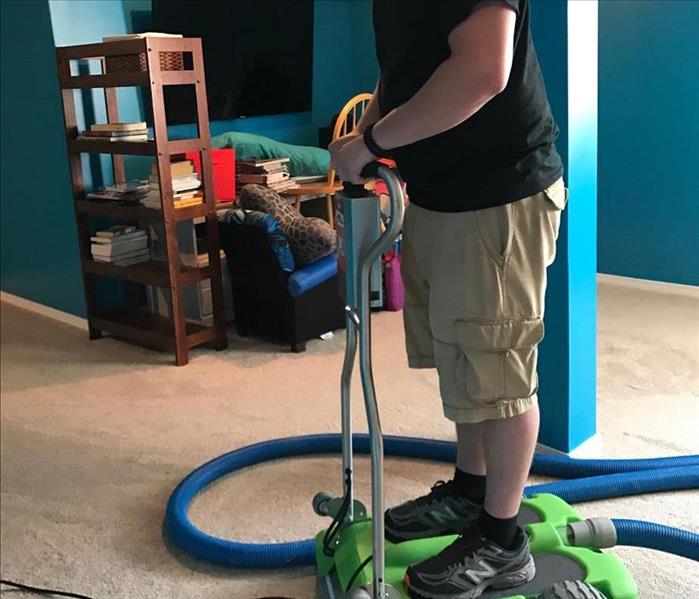 Our Des Moines Employee, Nick, Removing Carpet and Pad from a house in Ankeny
Our Des Moines Employee, Nick, Removing Carpet and Pad from a house in Ankeny
After a water intrusion we will use this type of equipment to remove the water from carpet and pad. In order to save the carpet and pad it must be a clean water loss. Meaning the leak had to come from a fresh water line. We use this equipment or something similar to extract the water. This machine is called a rover but we will also use a machine called a hydroX. They work the same way. You stand on both types of machines and the weight of the machine and the employee standing on the machine helps to squeeze out and suck up the water. The machine is self propelled using controls on the handle. The water is then pumped through tubes into a truck mounted holding tank to be disposed of. Air movers and dehumidifiers are still needed to remove moisture but this will remove the majority of excess water. We attempt when ever possible to save the carpet and pad but many times if not attended to fast enough delamination occurs. This is why it is so important to know who to call if you ever have water damage and to do it right away. This will minimize cost for the dry out process and minimize property damage.
Emergency Water Tips
6/22/2017 (Permalink)
Suffering a water loss can be a hectic and stressful time. Emotions run high and often times you don’t even know where to start! The first step should always be to identify the source of incoming water then shutoff or stop the water source if possible. Next make sure to turn off all electrical appliances around the affected area to reduce electrical hazards and turn off the circuit breakers supplying electricity to the wet areas. You will want to remove excess water by mopping or blotting and make sure to never use a regular vacuum to remove water! Keep furniture safe from additional damage by placing aluminum foil or wood blocks between furniture legs and wet carpeting/flooring and make sure to call your local SERVPRO to come assess the damage and get the drying process started immediately.
Dehumidifiers
5/4/2017 (Permalink)
We use dehumidifiers as one piece of equipment during our balanced drying system we use when we are cleaning up after a water loss. Dehumidification helps to minimize secondary damages. Dehumidifiers alone are not the only piece of equipment we use. These units are used to capture evaporated moisture in the air. We have to get the moisture out of the material and we use air movers and energy to get the water to evaporate. Once evaporated the vapor can be removed from the air with a dehumidifier. "Dehumidifiers are a sealed refrigeration system with defrost mechanism, fan, and water collection system. The dehumidifier removes energy from the incoming air, then returns this energy as sensible heat to the exiting air. During this energy removal process, water vapor condenses on the evaporator (cool) coil and is collected." - From Disaster Academy Training Manual
Desiccants
5/4/2017 (Permalink)
Desiccants are used on a larger scale water loss to remove moisture from the air. We used these as a tool in our balanced drying system in place or along side dehumidifiers on a larger scale project. Desiccants operate differently then dehumidifiers. Desiccants do not collect water through condensation. They vent moisture-laden air from inside the structure to outside the structure using a ventilation system. Desiccants are usually large units and sit outside the structure with venting tubes and air input tubes from and to the structure. They create the greatest vapor pressure and are best used when trying to dry wood flooring, plaster, or concrete. They work on the principle of sorption rather then condensation. Water vapor in this process is adsorbed by a silica gel and then that silica gel is reactivated by energy causing the desiccant to release its moisture to the outside air.
Can We Save Your Structure
5/4/2017 (Permalink)
In a lot of cases yes we can. A lot of building materials are made to get wet but NOT maintain wetness. It is very important to have a balanced drying system and start that system very quickly after water damage. Problems with saving materials occur when the water infiltration is caused by contaminated water.
Drywall can be saved if it is a clean water infiltration. Drywall is fragile when wet but when dried it is very strong. If seems are intact and there is no swelling or microbial growth then the drying process can begin.
Paneling and wallpaper are difficult to dry but cavity drying systems can be attempted if the material can not be replaced and it was a clean water infiltration.
Lath and Plaster require a very controlled drying process with aggressive evaporation and low humidity air but can sometimes be saved.
We use many different systems to dry different materials in different spaces. We have floor drying systems, cavity drying systems, and general drying systems.
We are here to help you. "Like it never even happened."
Water Damage Do's and Don'ts
2/23/2017 (Permalink)
Water damage from clean water is much different then contaminated, sewer water. These do's are only for clean water. It is important to hire a professional to help you dry out your home after water damage. With the right tools and pieces of equipment we can properly and safely dry out your home or business and the products with in it.
Do's
-Shut off the source of the water.
-Turn off electricity
-Remove as much excess water as possible by mopping and soaking up with towels.
-Wipe excess water from wood furniture.
-Put aluminum foil in between furniture legs and carpet.
Don'ts
-Enter a room with standing water. There could be a risk of electrical shock. Disconnect all power first.
-Leave rugs and furniture upholstery wet against and sitting on carpets. The fabrics could bleed between each other.
-Turn on your television or any other electronic.
-Do not use your household vacuum to try and suck up any water. They are not made for this.
 This is when you should call SERVPRO of Des Moines East & SW at 515-244-5511, and our team of professionals will make it ‘Like it Never Even Happened'
This is when you should call SERVPRO of Des Moines East & SW at 515-244-5511, and our team of professionals will make it ‘Like it Never Even Happened'





 24/7 Emergency Service
24/7 Emergency Service












